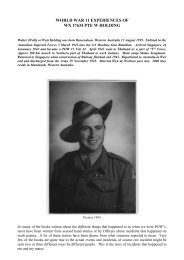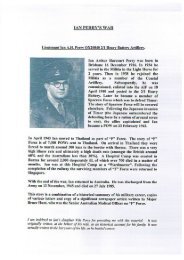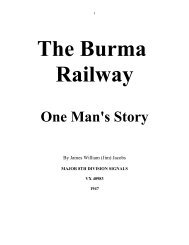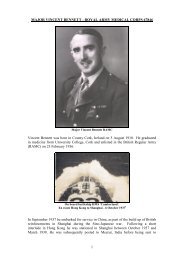Hoten pow camp, mukden, manchuria - Prisoners of War of the ...
Hoten pow camp, mukden, manchuria - Prisoners of War of the ...
Hoten pow camp, mukden, manchuria - Prisoners of War of the ...
You also want an ePaper? Increase the reach of your titles
YUMPU automatically turns print PDFs into web optimized ePapers that Google loves.
AMERICAN PRISONERS OF WAR IN MANCHURIA WW2<br />
Did you know that on 11 November (Remembrance Day, formerly Armistice<br />
Day) 1942 around 1,400 American <strong>Prisoners</strong> <strong>of</strong> <strong>War</strong> arrived at a Prisoner <strong>of</strong><br />
<strong>War</strong> Camp in Mukden, Manchuria. These men, in very poor physical condition,<br />
were from <strong>the</strong> Philippines, many having survived <strong>the</strong> Bataan March. Ano<strong>the</strong>r<br />
party <strong>of</strong> 100 had come from Singapore. This group comprised 81 British, 3 New<br />
Zealanders and 16 Australians (including one Australian Medical Officer).<br />
Amongst o<strong>the</strong>r work, <strong>the</strong> <strong>Prisoners</strong> were forced to work at a factory named<br />
“Manchu Kikai Kosaku Kabushiki Kaisha”, but usually referred to as MKK. (a<br />
machinery and tool factory). The prisoner’s accommodation (initial and<br />
subsequent) was adjacent to <strong>the</strong> factory. The captives experienced extreme<br />
climatic conditions, from 40 minus in winter to 100 plus (Fahrenheiht) in<br />
summer.<br />
Captain Des Brennan <strong>the</strong> Australian Medical Officer commented on <strong>the</strong> high<br />
death rate amongst <strong>the</strong> Americans. One report says 300 died in <strong>the</strong> first winter<br />
<strong>of</strong> 1942-43. On arrival in Mukden, <strong>the</strong> Americans were in much worse condition<br />
than <strong>the</strong> o<strong>the</strong>rs, who had come from Singapore. The work may not have been as<br />
harsh as for those on <strong>the</strong> Burma Thailand Railway or in <strong>the</strong> industrial works<br />
(mining, shipbuilding, foundries etc) in Japan. There were many difficulties, not<br />
<strong>the</strong> least being bombed in December 1944 by allied aircraft. A significant<br />
number <strong>of</strong> fatalities and injuries resulted from <strong>the</strong> bombing.<br />
Parties <strong>of</strong> <strong>of</strong>ficers arrived from o<strong>the</strong>r POW <strong>camp</strong>s in Formosa and Japan during<br />
April and May 1945. Some <strong>of</strong> <strong>the</strong>se were <strong>the</strong> senior <strong>of</strong>ficers who had been sent<br />
away from Singapore in 1942. They did not experience a Mukden winter.<br />
Although many <strong>of</strong> <strong>the</strong>se people have written about <strong>the</strong>ir experiences in Mukden,<br />
<strong>the</strong>y really did not experience <strong>the</strong> worst period.<br />
The prisoners were finally liberated by Americans around 16 August 1945<br />
followed by <strong>the</strong> Russians 4 or 5 days later.<br />
By Lt Col Peter Winstanley OAM RFD (Retired) JP<br />
email pgwinstanley@cambraivillage.com.au website www.<strong>pow</strong>s-<strong>of</strong>-japan.net










